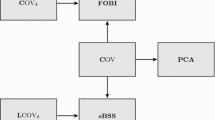Abstract
Prior to interpretation and further analysis, many datasets must first be separated into regional and residual components. Traditional techniques are either subjective (e.g., graphical methods) or nonrobust (e.g., all least-squares based methods). Bathymetric data, with their broad spectrum, pose serious difficulties to these traditional methods, in particular those based on spectral decomposition. Spatial median filters offer a solution that is robust, objective, and often defines regional components similar to those produced graphically by hand. Characteristics of spatial median filters in general are discussed and a new empirical method is presented for determining the width of the robust median filter that accomplishes an optimal separation of a gridded dataset into its regional and residual components. The method involves tracing the zero-contour of the residual component and evaluating the ratio between the volume enclosed by the surface inside this contour and the contour's area. The filter width giving the highest ratio (or mean amplitude) is called the Optimal Robust Separator (ORS) and is selected as the optimal filter producing the best separation. The technique allows a unique and objective determination of the regional field and enables researchers to undertake reproducible separations of regional and residual components. The ORS method is applied to both synthetic data and bathymetry/topography of the Hawaiian Islands; ways to improve the technique using alternative diagnostic quantities are discussed.
Similar content being viewed by others
REFERENCES
Claerbout, J. F., 1985, Imaging the earth's interior: Blackwell, London, 398 p.
Davies, D. F., 1992, Temporal variation of the Hawaiian plume flux: Earth Planet. Sci. Lett., v. 113,no. 1/2, p. 277–286.
Grant, F. S., and West, G. F., 1965, Interpretation theory in applied geophysics: McGraw-Hill, New York., 583 p.
Gupta, V. K., and Ramani, N., 1980, Some aspects of regional-residual separation of gravity anomalies in a Precambrian terrain: Geophysics, v. 45,no. 9, p. 1412–1426.
Huber, P. J., 1981, Robust statistics: Wiley, New York, 308 p.
Ku, C. C., Telford, W. M., and Lim, S. H., 1971, The use of linear filtering in gravity problems: Geophysics, v. 36,no. 6, p. 1174–1203.
Levitt, D. A., and Sandwell, D. T., Modal depth anomalies from multibeam bathymetry: Is there a south Pacific superswell?: Earth Planet. Sci. Lett., v. 139,no. 1/2, p. 1–16.
McNutt, M., Sichoix, L., and Bonneville, A., 1996, Modal depths from shipboard bathymetry: There IS a south Pacific superswell: Geophys. Res. Lett., v. 23,no. 23, p. 3397–3400.
McNull, M. K., 1988, Thermal and mechanical properties of the Cape Verde Rise: J. Geophys. Res., v. 93,no. B4, p. 2784–2794.
McNutt, M. K., and Shure, L., 1986, Estimating the compensation depth of the Hawaiian swell with linear filters: J. Geophys. Res., v. 91,no. B14, p. 13915–13923.
Mesko, A., 1965, Some notes concerning the frequency analysis for gravity interpretation: Geophys. Prosp., v. 13,no. 3, p. 475–488.
Mickus, K. L., Aiken, C. L. V., and Kennedy, W. D., 1991, Regional-residual gravity anomaly separation using the minimum-curvature technique: Geophysics, v. 56,no. 2, p. 279–283.
Nettleton, L. L., 1976, Gravity and magnetics in oil prospecting: McGraw-Hill, New York, 464 p.
Olson, P., 1990, Hot spots, swells and mantle plumes, in Ryan, M. P., ed., Magma transport and storage: John Wiley, New York, p. 33–51.
Renkin, M. L., and Sclater, J. G., 1988, Depth and age in the north Pacific: J. Geophys. Res., v. 93,no. B4, p. 2919–2935.
Ribe, N. M., and Christensen, U. R., 1994. Three-dimensional modeling of plume-lithosphere interaction: J. Geophys. Res., v. 99,no. B1, p. 669–682.
Rousseeuw, P. J., and Leroy, A. M., 1987, Robust regression and outlier detection: John Wiley and Sons, New York, 329 p.
Simpson, R. W., Jachens, R. C., Blakely, R. J., and Saltus, R. W., 1986, A new isostatic residual gravity map of the conterminous United States with a discussion on the significance of isostatic residual anomalies: J. Geophys. Res., v. 91,no. B8, p. 8344–8372.
Smith, W. H. F., 1990, Marine Geophysical Studies of Seamounts in the Pacific Ocean Basin: PhD dissertation, Columbia Univ., New York, 216 p.
Spector, A., and Grant, F. S., 1970, Statistical models for interpreting aeromagnetic data: Geophysics, v. 35,no. 2, p. 293–302.
Stein, C. A., and Stein, S., 1992, A model for the global variation in oceanic depth and heat flow with lithospheric age: Nature, v. 359,no. 6391, p. 123–129.
Stein, S., and Stein, C. A., 1997, Sea-floor depth and the Lake Wobegon effect: Science, v. 275, p. 1613–1614.
Telford, W. M., Geldart, L. P., Sheriff, R. E., and Keys, D. A., 1986, Applied geophysics: Cambridge Univ. Press, London, 860 p.
Thompson, K., 1990, Area of intersection: Two circles, in Glassner, A. S., ed., Graphics gems: Academic Press, San Diego, p. 43–46.
Watts, A. B., 1978, An analysis of isostasy in the world's oceans, 1, Hawaiian-Emperor seamount chain: J. Geophys. Res., v. 83,no. B12, p. 5989–6004.
Watts, A. B., and ten Brink, U. S., 1989, Crustal structure, flexure, and subsidence history of the Hawaiian islands: J. Geophys. Res., v. 94,no. B8, p. 10473–10500.
Wessel, P., 1993a, Observational constraints on models of the Hawaiian hot spot swell: J. Geophys. Res., v. 98,no. B9, p. 16095–16104.
Wessel, P., 1993b, A reexamination of the flexural deformation beneath the Hawaiian islands: J. Geophys. Res., v. 98,no. B7, p. 12177–12190.
Author information
Authors and Affiliations
Rights and permissions
About this article
Cite this article
Wessel, P. An Empirical Method for Optimal Robust Regional-Residual Separation of Geophysical Data. Mathematical Geology 30, 391–408 (1998). https://doi.org/10.1023/A:1021744224009
Issue Date:
DOI: https://doi.org/10.1023/A:1021744224009




